Montana is home to a wide selection of wild animals. Some of them are downright dangerous under certain conditions. Look below to find a list of the deadliest critters in Big Sky Country.
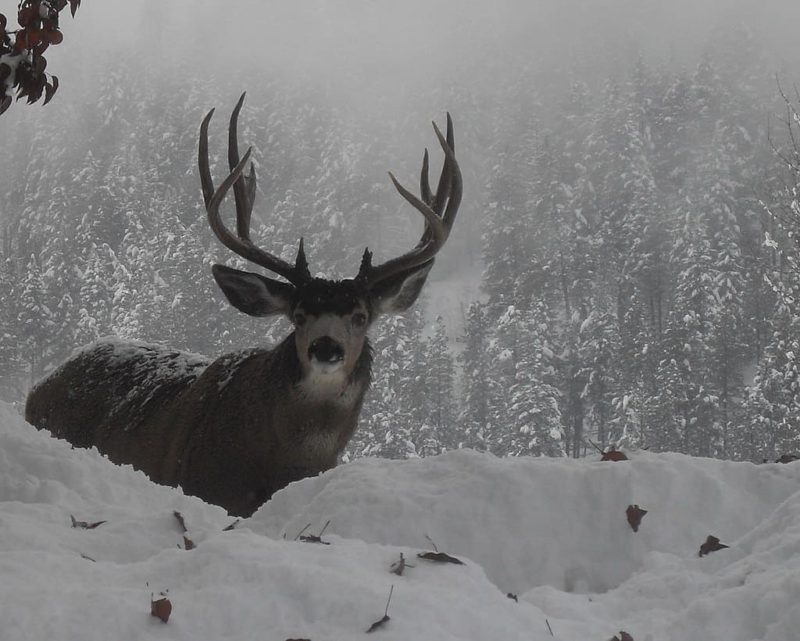
Deer (Odocoileus hemionus) (Odocoileus virginianus)
Surprisingly Montana’s deadliest animal is not the grizzly bear. It’s mule deer and white-tailed deer. Deer are a leading vector in the United States of animal-related deaths.
Between 120 and 200 people in the United States die each year as a result of deer/vehicle collisions. Incidentally, Montana ranks second in the United States for deer/ vehicle collisions.
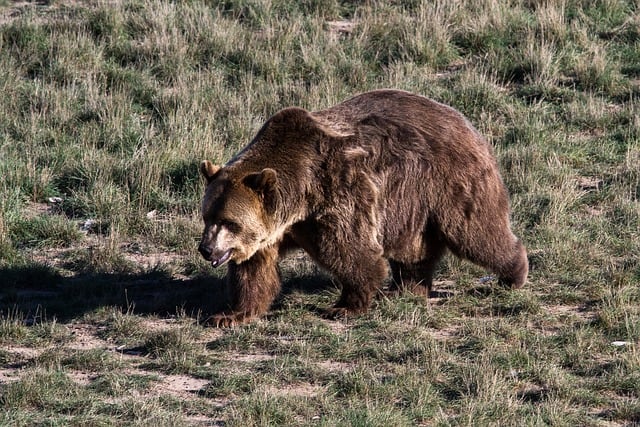
Grizzly Bear (Ursus arctos horribilis)
Grizzly bears are not only Montana’s state animal, but they’re also fierce predators, and at the top of the food chain in any ecosystem they inhabit. With a population of 1,800 to 2,000 bears, Montana has more grizzly bears than any other U.S. state besides Alaska. Alaska has a population of around 30,000 of them, including coastal brown bears. What we call grizzly bears are actually inland brown bears.
According to Montana Fish, Wildlife, and Parks, you have a chance of running into a grizzly anywhere in western Montana.
The U.S. Fish and Wildlife Service has designated 6 grizzly bear recovery zones in the contiguous United States. The following 4 lies completely or partially within the state of Montana.
Montana grizzly bear recovery zones
- The Northern Continental Divide, which is in the northwestern part of the state, and includes Glacier National Park holds the majority of Montana’s grizzly bears. The latest estimate puts the grizzly population in the northern continental divide ecosystem at around 1,100 bears.
- The Greater Yellowstone Ecosystem has Yellowstone National Park at its heart. However, it is nearly 10 times larger than the park itself, with interconnected wildlands in Montana as well as parts of Wyoming and Idaho. The GYE has around 1,000 grizzly bears.
- The Cabinet Yaak ecosystem, which is in northwestern Montana and northern Idaho, holds around 55 grizzly bears.
- The Bitterroot ecosystem lies in Western Montana. As of the latest population estimate, there were no resident grizzlies in this area.
Grizzly bears in the contiguous 48 states are listed as a threatened species on the federal endangered species list. Consequently, it’s illegal to hunt them, and the respective state governments do not hold the jurisdiction to make decisions in their management.
Grizzly attacks in Montana
Grizzly bear attacks on humans are relatively rare, but that’s small comfort to the guy that’s being attacked. There are several incidents where humans are injured by grizzly bears each year within the state of Montana. Here’s an example that took place in 2021 near Mammoth Hot Springs in southern Montana.
Here’s another example from the year 2021 that took place near Ovando, Montana.
The trouble with Montana’s grizzly bears is that some of the most dangerous places as regards to running into a grizzly bear are the same places that people frequent to hunt elk, for example, or cast a fly into the state’s famous cutthroat trout waters.
There are some safety precautions you can take to lessen the odds that you’ll have grizzly bear trouble in the backcountry.
For one, travel in a group and make plenty of noise. The vast majority of grizzly attacks on humans are defensive in nature and happen when the human takes the bear by surprise.
Also, be cognizant of the direction the breeze is blowing as you travel. If the wind is blowing your scent away from the bear that’s up ahead, there’s less chance that it’ll know you’re coming.
The following tips will keep you safer at your campsite and are also located in the article entitled Camping in Bear Country.
Setting Up Camp in Bear Country
- Use some common sense in choosing a campsite. For instance, don’t pitch your tent alongside a well-used trail with fresh bear tracks on it. Also, avoid berry patches, salmon streams, or any other obvious bear attractant.
- Set up your camp so the odds are as low as possible that a bear encounter will disturb your slumber in the middle of the night. This means that your tent should be pitched a long distance from where you cook and eat your food. From my reading, the distance should be at least a hundred yards.
- Your food and food scraps need to stay in the cooking and eating area. Place them in a bear-proof container or a bear bag, and then hang the container far enough off the ground that it isn’t an issue for a hungry Grizzly. If you’re in Black Bear country, they can climb trees, so you’ll need to get a little more creative with how you hang your essential items. Also, store any aromatic items that might attract bears with your food.
- Always sleep in a tent or a camper if you’re near the road when you’re in bear country.
At Your Tent
- Never take food back to your tent
- Never sleep in the same clothes that you cooked or ate in.
- You should have good dependable light and a canister of bear spray in your tent with you. You should already be familiar with how and when to use bear spray. The following quote is from Mountain Journal. “Scientists found that bear spray was 92 percent effective in deterring attacks from the three species of North American bears—brown, black and polar— in Alaska between 1985 and 2006; 98 percent of people carrying bear spray who got into close encounters with bears were uninjured.” Source
Some grizzly bear attacks, such as the one near Ovando, are predatory in nature. Making noise will not help you avoid a predatory bear. Predatory attacks are more likely to occur in late summer and fall when all bears are going through hyperphagia leading up to their winter hibernation. Most black bear attacks are carried out by hyperphagic bears. When you’re in bear country, it’s always a good idea to have a canister of bear spray at the ready and to know how to deploy it.

Black Bears (Ursus americanus)
The American black bear lives exclusively in North America. They are also the most common bear in North America. Their range begins in Alaska and northern Canada and extends south into central Mexico. Today, there are black bear populations in 38 U.S. states, 11 Canadian provinces, and 7 Mexican states. See
What do black bears look like?
Adult black bears are anywhere from 50 to 85 inches long from the tip of the nose to the tip of the tail. Their average height is around 30 inches at the shoulder. The normal black bear’s weight range is from 140 to 400 pounds. However, males can be up to 70% larger than females. Standing on its hind legs, a large male black bear can be over seven feet tall. What’s more, some giant-sized individuals weigh over 800 pounds.
Even though they are named black bears, their colors can vary from black, blue-grey, cinnamon, brown, blue-black, and on infrequent occasions, a black bear can even be white. Although most Montana bears are black, a small percentage of them are brown, cinnamon, or dark blond. Some black bears have a V-shaped white patch on their chest.
Other features that black bears have are long brown snouts, short tails, and small brown eyes, although their eyes are blue at birth.
Black bears lack the shoulder hump that brown bears or grizzly bears have. In areas that both species inhabit, the hump, or the lack thereof, is a distinguishing feature.
Black bears are crepuscular animals. This means that their most active times of day are dusk and dawn.
How dangerous are black bears?
The knee-jerk response to that question is that black bears are timid, cautious animals; they’re more afraid of you than you are of them. All that is true most of the time. However, that’s only most of the time.
Here’s an example of a black bear attack that took place in 2012 in the Bob Marshall Wilderness. This particular black bear showed evidence of being conditioned to human food. This is often a contributing factor in both black bear and grizzly attacks.
The following is from the Krebs Creek article titled Are Black Bears Dangerous to Humans?
“Black bears are not aggressive generally. They’re omnivores, which means their diet includes plant material but also meat. At times, black bears’ diets have been documented to consist of 96% plant material. This makes them one of the least predacious of all carnivores. However unaggressive they might be most of the time, black bears are still dangerous. In fact, at least one person is killed somewhere in North America each year by a black bear.
From 2001 through 2021, Black Bears killed twenty-eight people in North America. That’s a fact that flies in the face of the other points we know about these animals.
According to Doctor Stephan Herrero in his book “Bear Attacks, Their Causes and Avoidance,” from 1900 through 1980, 90% of the fatal attacks by black bears on humans in the United States and Canada were carried out by a predatory animal. In other words, 90% of the time, when black bears attack people, it’s because they view them as a food source.” When predatory black bear attacks happen, it’s usually in the late summer or early fall. This is when bears enter a hyperphagic state.
I’ll leave off there; if you want to read the rest of the article, you can click on the link.
The point is not to scare the reader. Black bear attacks are very rare. However, we’re dealing with unpredictable wild animals that have the ability to kill you with very little effort if that’s what they decide to do, and in rare circumstances, that’s exactly what they decide to do. Take that into consideration before you feed one.
“90% of the time, when black bears attack people, it’s because they view them as a food source.”Dr. Stephan Herrero “Bear Attacks, Their Causes and Avoidance,”
To see how to handle the situation if you encounter a bear in the wild, and how to set up your camp in bear country look at Camping in Bear Country
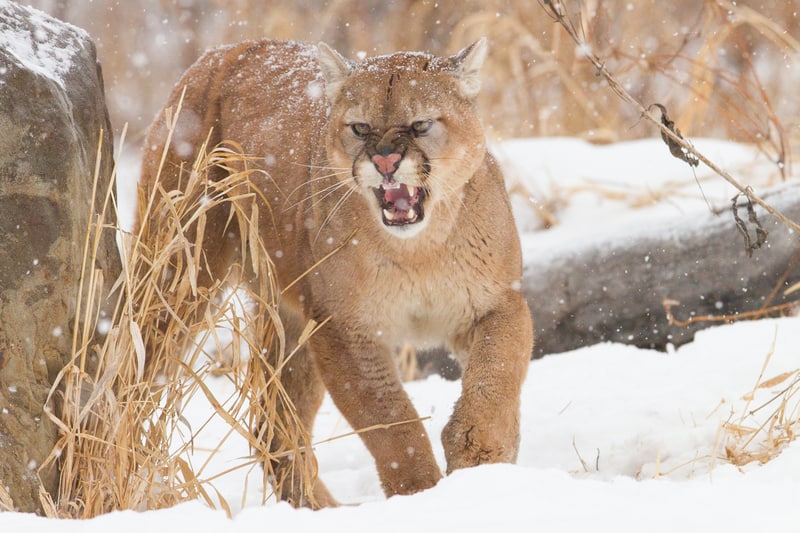
Mountain Lions (Puma concolor)
The majority of the time, mountain lions use their ghost-like skills to avoid human contact. On rare occasions, though, they attack humans. Below are a few of the reasons why.
The mountain lion is the second largest cat in the western hemisphere and an apex predator in the state of Montana.
According to the state of Montana’s mountain lion field guide, the treasure state is home to between 5,700 and 7,600 of these big cats. They are primarily concentrated in the western 1/3 of the state. However, there are mountain lion populations in central and southeastern Montana as well.
Due to the fact that they live over a wide geographical area, mountain lions have a long list of regional names. In recent years, their scientific name was even changed from Felis concolor to Puma concolor. Some common names that mountain lions go by are cougar, panther painter, Andean Mountain lion, and puma.
Where are mountain lions typically found?
Mountain lions live on all three of the American continents. Their range begins in Canada’s Yukon territory and extends south through parts of North America, Central America, and South America to the southern tip of Argentina.
In Canada, the biggest populations of them are in British Columbia and Alberta. On the other hand, in the continental United States, they mainly live in the western United States and Florida in the southeast. In Florida, the cougar is called the Florida panther.
You’ll notice that all of these habitat types are good for deer. This is no coincidence. Deer are the mountain lion’s main source of prey. In fact, Mountain lions account for around 18 pounds of biomass and consume around 10 pounds of meat per day. To do this, an adult mountain lion has to kill a deer or a deer’s equivalent in meat around once a week. In Montana, they also prey on elk, moose, Rocky Mountain bighorn sheep, Rocky Mountain goats, pronghorns, feral horses, coyotes, raccoons, birds, rats, porcupines, skunks, snakes, small pets, domestic livestock, and literally any other native wildlife they can catch. See
Do mountain lions ever harm humans?
I’ve taken much of the following section from another one of my blog posts entitled “Are Mountain Lions Dangerous?” Found here.
Fatal mountain lion attacks on humans are extremely rare. In fact, there are only 20 records of fatal mountain lion attacks on humans in all of North America in the last 100 years. Don’t let that fact lull you into a complete sense of false security, though. There have been many more mountain lion attacks over the years that didn’t result in a fatality. Mountain lions are, in fact, dangerous.
A mountain lion is a formidably tough wild predatory animal. They can run 40 to 50 miles per hour for short bursts. Additionally, they can leap 18 feet vertically and 40 feet horizontally to catch their prey. These ninja-like predators typically stalk their prey from behind and then leap on an animal’s back. They then crush their cervical spine or larynx with their powerful jaws. They have a bite force of 750 pounds per square inch.
Some factors that cause mountain lions to attack humans
- If the cougar has an injury or some sort of impairment that prevents it from killing its normal prey, it’ll be more likely to look at a person as potential prey.
- Male mountain lions engage in fights for territory. Some of their battles are to the death. A percentage of cougar attacks on humans are perpetrated by hungry semi-juvenile toms that have been kicked out of territories with a more abundant food supply.
- Scientific data suggests that mountain lions that were orphaned at a young age are more likely to attack humans. This is possibly because they missed the part of their training where their mothers taught them that humans are to be feared.
I don’t intend to scare the reader from being outdoors. According to Greg Lemon, who is the Montana Fish, Wildlife and Parks Communications and Education Division Administrator, it’s really rare for mountain lions to attack people. See The drive you take to get into mountain lion country is statistically much more dangerous than being there is.
However, you shouldn’t be so naive as to think that bad things never happen. Here is an occurrence that took place at the Marshall Mountain ski area, which is about seven and a half miles from Missoula, Montana.
Click on the “Are Mountain Lions Dangerous?” link at the beginning of this section for more information on this subject.
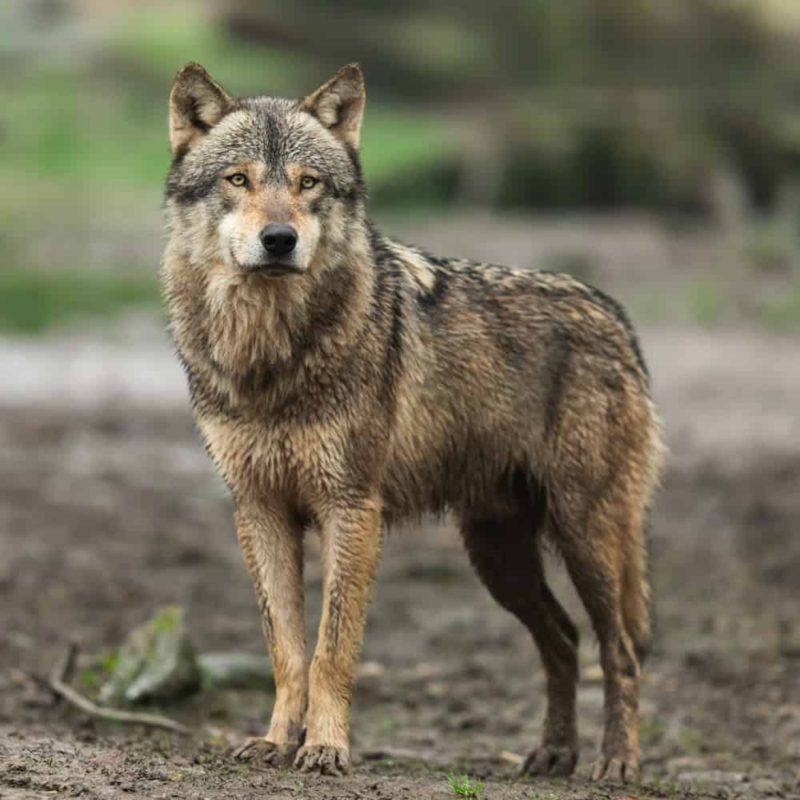
Gray Wolves (Canis lupus)
As of the end of the year 2021, there were 1,141 grey wolves in 192 packs within the state of Montana. The gray wolf is an apex predator. Their diet requires that they kill a large number of large mammals throughout the course of a year.
Therein lies the conflict they have with a lot of Montanans. Elk hunters don’t like them because they eat a lot of elk. Additionally, ranchers don’t like them because they sometimes add some variety to their diets with cattle and sheep.
Wolf attacks on humans are extremely rare, but when they do occur, wolves that have been habituated to human food and garbage are usually to blame.
Here is an account from 2005 where a man was killed by a pack of wolves in northern Saskatchewan.

Moose (Alces alces)
Every year, moose are responsible for more attacks than any other North American wildlife species. In fact, Alaskan moose attack humans more than all the state’s large predators, which are black bears, grizzly bears, brown bears, polar bears, and wolves combined. See
Here is an account from 1999 where a moose attacked and killed a man near Red Lodge, Montana.
When Are the Moose Most Dangerous?
The time of year and the annual cycles of mating and raising young have some influence on when moose will exhibit more natural aggression. Knowing when these times are will help you be more vigilant in avoiding otherwise dangerous situations.
Are bull moose dangerous?
Normally, male (bull) moose are more aggressive than female moose (cows), especially during the fall mating season. This occurs in late September through early October. During the breeding season or “rut,” bull moose are competing for the right to breed cow moose. This makes them into territorial animals that are more irritable and restless. At such times, the probability of one attacking you increases.
Are cow moose dangerous?
Cow moose are more likely to be aggressive from late spring through late summer when they have young moose calves to protect.
Moose are also more likely to attack in the winter if emaciated or tired from walking in deep snow.
Another reason why a moose can become dangerous and aggressive is a case of a brain worm infection. These infections make the animal less inclined to behave in a predictable manner and thus more of a danger to unassuming humans. Also, see
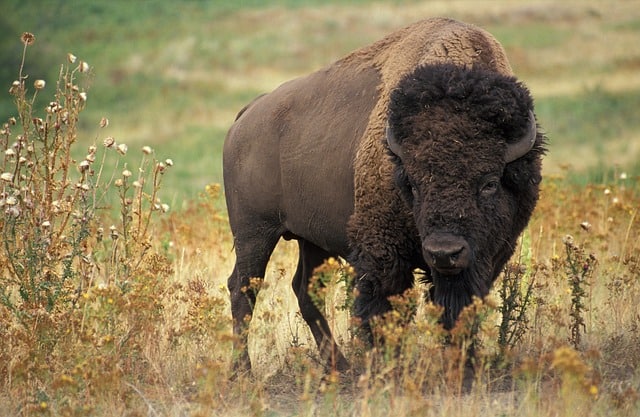
American Bison (Bison bison)
At least 1 or 2 people are injured by bison in Yellowstone National Park each year. A couple of factors contribute to this statistic.
First of all, the park sees a crushing number of people each year with an almost surreal atmosphere as people crowd into close proximity to these animals to see them up close.
Bison that seem to be placid lumbering animals that are paying you no attention snap, and in a split second, they’re smashing, stomping, and goring you because you entered their bubble.
These animals are extremely powerful and athletic and are capable of doing tremendous damage to the human body.
Here’s an article on a bison mauling what was the 3rd person to be injured in Yellowstone in 2022.
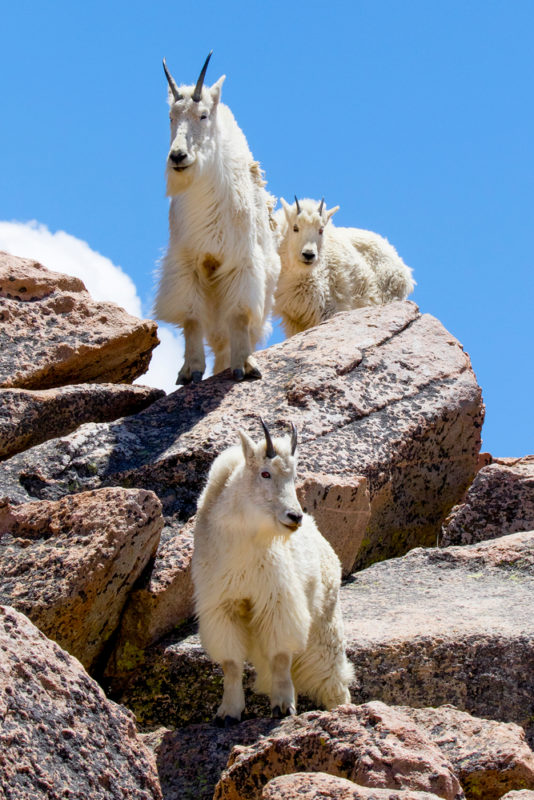
Rocky Mountain Goats ( Oreamnos americanus)
Rocky Mountain goats are native to the higher altitudes in several of Montana’s mountain ranges.
Mountain goat/human conflicts generally occur in similar settings to what causes the bison problems in Yellowstone National Park. When the mountain goats and people become accustomed to each other’s presence, and people get too close to the mountain goats, it’s a recipe for trouble.
Rocky Mountain goats may look and act peaceful, but they become fierce when they feel threatened. There is at least one account of a mountain goat killing a grizzly bear with its horns.
There’s also one account of a Rocky Mountain goat goring a hiker to death. See, No matter how accustomed people and mountain goats might become to each other; they’re still wild animals, so keep your distance. See
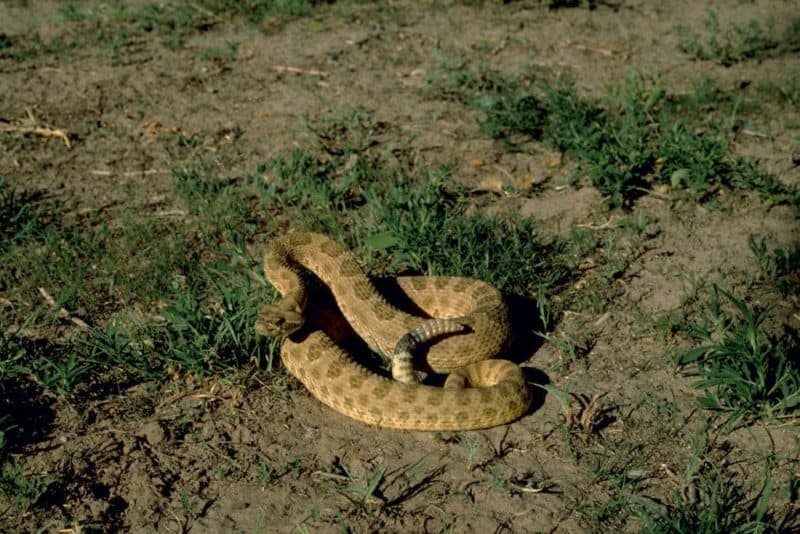
Prairie Rattlesnake (Crotalus viridis)
The prairie rattlesnake, which is sometimes also called the western rattlesnake, is Montana’s only venomous snake.
This stout rattlesnake has a triangular head with a blunt nose and narrow neck. As with all rattlesnakes, they have a heat-sensing pit between their nostril and their eye. Their fangs are hollow and hinged, allowing them to be folded back against the roof of their mouth.
They range in length anywhere between 39 to 60 inches long. Their coloring varies from a greenish-gray or greenish-brown to a light brown; a series of dark brown blotches with white edges run the length of its body, with smaller, lighter blotches running along the sides. The blotches merge into rings on its tail. Their belly is white to light yellow with no blotches. At the end of their tail are shell-like hollow scales which form the rattle.
Female Prairie Rattlesnakes can give birth to anywhere between 4 to 25 young in late summer or early fall. This all can vary depending on environmental conditions and the availability of small mammals such as rodents for food. The young are born toxic and can be harmful if they bite you.
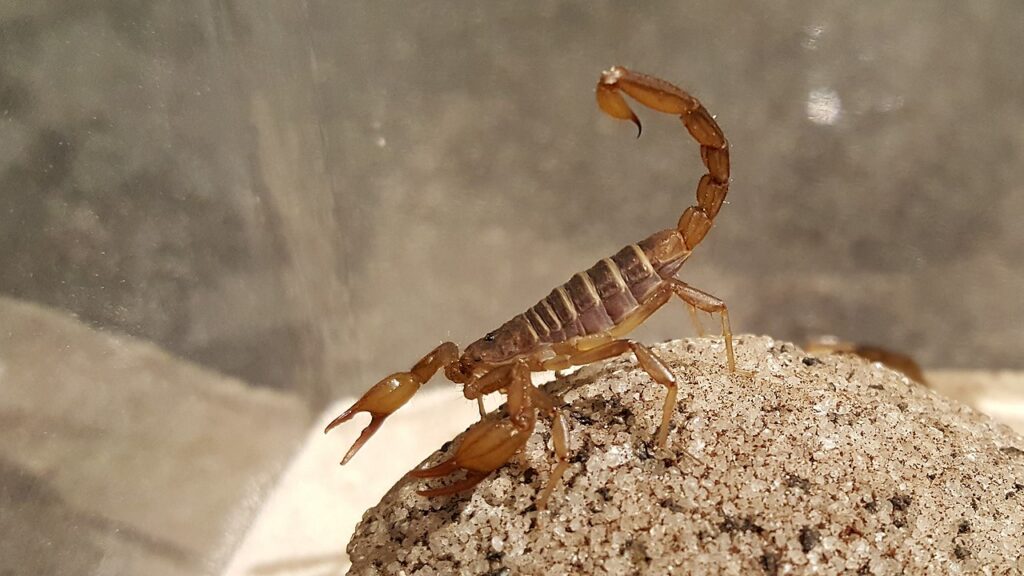
Northern Scorpion (Paruroctonus boreus)
The northern scorpion or boreal scorpion is a species of scorpion in the family Vaejovidae. It is the only species of scorpion found in Montana.
Northern scorpions are found in 12 U.S. states and 3 Canadian provinces. The northern scorpion species range begins in northern Arizona and goes north to southwestern Canada. The U.S. states that have Northern scorpions are Arizona, California, Nevada, Utah, Idaho, Wyoming, Montana, North Dakota, South Dakota, Oregon, and Washington. In Canada, Northern Scorpions live in southern British Columbia, southern Alberta, and southern Saskatchewan. See
Stings from northern scorpions usually aren’t more serious than a bee sting. However, in the event of an allergic reaction, more serious complications could result. Treat a northern scorpion sting the same way you would a bee or wasp sting, with ice and possibly Benadryl. Observe the patient for any serious complications and be ready to seek more in-depth medical attention if they occur.
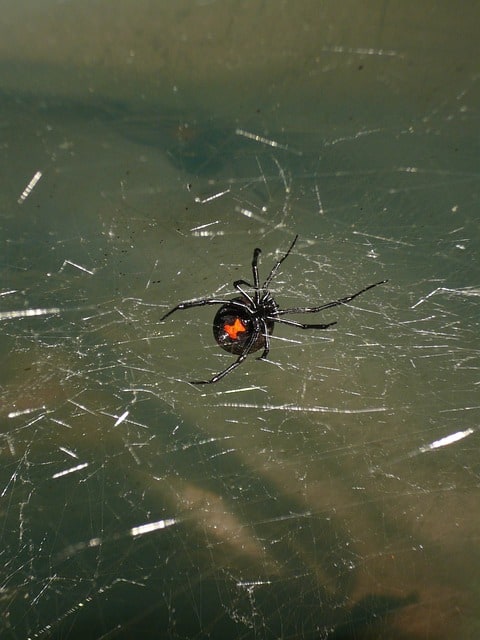
Black Widow Spider (Latrodectus hesperus) (Latrodectus variolus)
Montana has the Western Black Widow Spider and the Northern Black Widow Spider.
The average body length of a mature Western Black Widow Spider is around 1/2 an inch. Their legs spread out 1 1/2 to 2 inches. Males are around 1/3 the size of females. The female’s body is shiny black with what is generally a red hourglass shape on the bottom of the abdomen. However, the hourglass can also be yellow or white in color.
Northern Black Widow spiders are similar looking to Western Black Widow Spiders. There are some differences, though. For example, the hourglass on the belly is not connected but is instead split into two red triangles. Also, the female’s abdomen is black with a row of reddish dots along the top and diagonal whitish bands along the sides. On the other hand, males have four diagonal whitish bands on each side of the abdomen. See
Black widows have neurotoxic venom that affects the nervous system of bite victims. Their bite is dangerous, particularly to small children and the elderly. However, a black widow bite is rarely fatal. However, rarely does not mean never. Black Widow bites kill 4 to 8 people each year.
There is an antivenom available for black widow bites. However, physicians only use it in rarely serious cases.
Black widow spiders are most common in western Montana but are also present the in central and eastern portions of the state. They prefer dark spaces such as in the crevasses in woodpiles, in empty flowerpots, in crawl spaces, and in outbuildings.
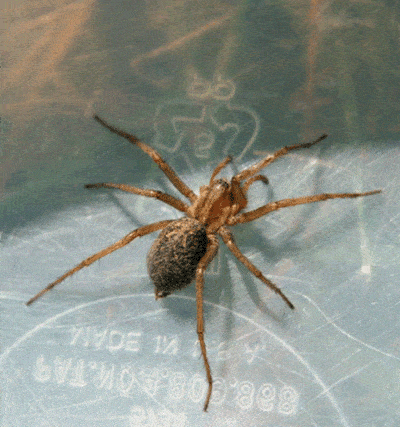
Hobo Spider (Eratigena agrestis)
Hobo spiders which are also called aggressive house spiders, exist in most of central and western Montana. These spiders are common in the dark corners within people’s homes.
There has been some debate as to whether or not the bite from hobo spiders causes necrotic lesions. The latest research seems to indicate that this is not the case.
However, if you accidentally press a hobo spider against your skin in an article of clothing, it may possibly bite you. In the event that this happens, wash the site of the bite thoroughly with soap and water, then monitor it for excessive redness or inflammation. Seek medical attention if these occur.
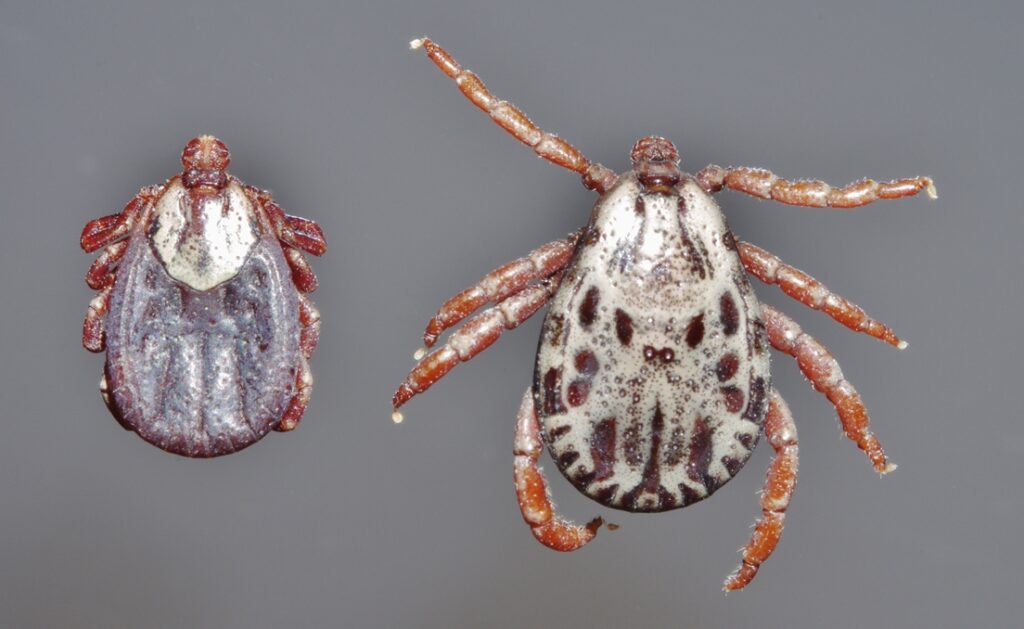
Ticks
Ticks carry some nasty diseases that they can transmit to humans when they bite them to suck their blood.
I copied the following chart from the Montana DPHHS. Their website is located here. The chart illustrates all the different tick-borne illnesses found in Montana, along with the tick variety responsible for transmitting them.
Note that although Lyme Disease is the most common tick-borne disease in Montana, the tick responsible for transmitting it to humans does not exist in the state. All cases of Lyme Disease in Montana are contracted in some place other than Montana.
| Disease/causal organism | Incidence in Montana | Symptoms | Tick vectors |
| Rocky Mountain spotted fever/rickettsiosis (a bacterium, Rickettsia rickettsii) | Rare, about 8 cases per year, on average, are reported in Montana. | Initially, a general feeling of malaise and/or aches. A characteristic rash develops, starting on the wrists and ankles and later spreading to the rest of the body, including palms and the soles of feet. High fever is associated with infections. | Rocky Mountain wood tick, American dog tick. |
| Tularemia (a bacterium, Francisella tularensis) | Rare; only 5 cases on average are reported in Montana. Can be widespread in wild animals, particularly rabbits. | Sudden high fever, general weakness, and swelling/pain of the lymph nodes. | Rocky Mountain wood tick, American dog tick. Most human infections occur from contact with the blood of infected animals (e.g., while skinning rabbits). |
| Colorado tick fever/biphasic fever (a virus) | Rare; only 4 cases, on average, are reported in Montana. | Generally flu-like, including aching, fever, chills, and fatigue. This typically lasts for 1 to 3 days. More severe complications sometimes develop. | Rocky Mountain wood tick, American dog tick |
| Tick-borne relapsing fever/borreliosis (a bacterium, Borrelia hermsii) | Very rare. | Rapidly developing fever 3 to 10 days after initial infection. Fever declines after about 4 days but may recur in multiple cycles. | Soft ticks of the genus Ornithodoros that are associated with rodents (e.g., chipmunks, pine squirrels). Human infections typically occur when camping in rustic cabins inhabited by infected rodents. |
| Lyme disease (a bacterium, Borrelia burgdorferi) | Most common tickborne illness in Montana residents even though all cases acquired disease out of state. Thirteen cases on average. Most US cases are from the northeastern, mid-Atlantic, and north-central US. | Symptoms that occur 3 – 30 days after a tick bite include fever, chills, headache, fatigue, muscle and joint aches. Rash occurs in 70% – 80% of infected cases. It is 12 inches or more and may be located on any area of the body. Later signs and symptoms severe headaches and neck stiffness, arthritis with joint swelling, and facial or Bell’s palsy. | Blacklegged tick or deer tick. Not found in Montana. Most people are infected by immature ticks that are less than 2mm in size. |
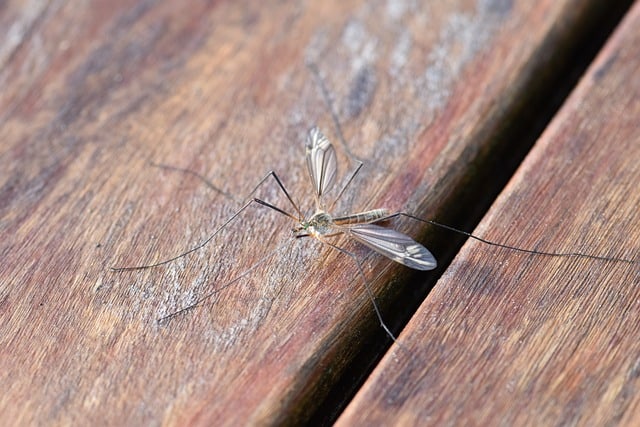
Mosquitos
Worldwide, mosquitos are responsible for the loss of more human life than any other organism in that they carry diseases that kill a lot of people. In fact, according to the Centers for Disease Control, 750,000 people die each year from mosquito-borne illnesses.
In Montana, West Nile Virus is the mosquito-borne illness of main concern. The Western Encephalitis Mosquito (Culex tarsalis) is the most common West Nile Virus carrier.
The best thing to reduce the risk of exposure to West Nile Virus is to wear long sleeves and long pants during peak mosquito season and use an insect repellent that is high in one of the following:
- DEET
- Picaridin (known as KBR 3023 and icaridin outside the US)
- IR3535
- Oil of lemon eucalyptus (OLE)
- Para-menthane-diol (PMD)
- 2-undecanoate
Also, see
Recent Posts
The only venomous snakes in Washington State are Northern Pacific Rattlesnakes. The Northern Pacific Rattlesnake (Crotalus oreganus oreganus) is a sub-species of the Western Rattlesnake. Anyone...
Skunks are not classified as true hibernators. But they go into a state of torpor when the weather gets cold. Skunks are light sleep hibernators, along with opossums, bears, and raccoons. ...
